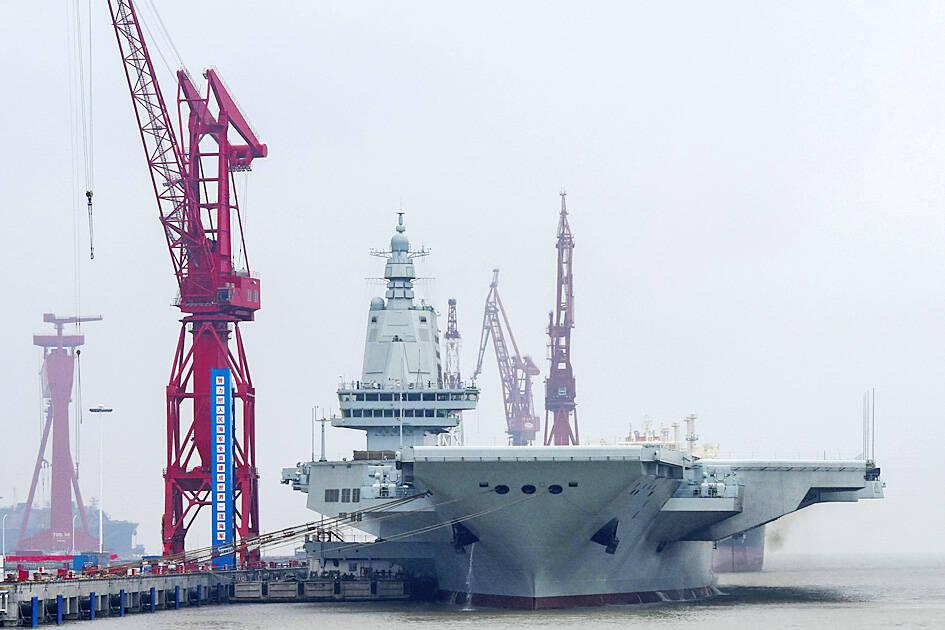China’s naval fleet has grown to 360 warships, with a potential to grow even further to 400-440 vessels and challenge the US Navy, the Institute for National Defense and Security Research said yesterday.
The think tank published the 2024 edition of its annual Report on the Development of the Chinese Communist Party’s (CCP) military and politics, which included an article on the country’s naval build-up by researcher Chen Liang-chih (陳亮智).
The article cites reports from the US Congressional Research Service, the UK International Institute for Strategic Studies and other sources, to estimate that the Chinese navy has about 360 ships and will continue to grow in the short-term.

Photo: Xinhua via AP
The main vessels of China’s navy include three aircraft carriers, 45 destroyers, 40 frigates, 70 submarines, 40 amphibious assault ships, and 60 auxiliary vessels, the report said.
This does not include smaller ships such as missile boats or small frigates.
China’s latest warship, an aircraft carrier named Fujian (福建), is currently undergoing sea trials, it said.
It is highly anticipated as it is equipped with an advanced electromagnetic catapult system, something only the US Ford-class aircraft carriers are equipped with, it said.
The Chinese navy already has three Type 075-class amphibious assault ships, and is expected to launch the new more advanced Type 076 model sometime this year, the report said.
The new ships may have the ability to launch fixed-wing aircraft and drones, significantly strengthening the Chinese navy’s ability to carry out amphibious assaults, it said.
Part of the explanation for China’s rapid progress in this field is the CCP’s decision to build several world-class shipyards, the report said.
In the future, competition between the US and Chinese navies is likely to intensify, with larger fleets, more advanced vessels and weapons systems deployed, and larger military exercises, it said.
This competition is likely to have major effects on the Asia-Pacific region, if not the whole world, it said.
The Ministry of National Defense said in recent reports that it has invested in new naval weapons systems to combat the threat posed by China’s navy, including the new domestic submarine program and Hsiung Feng (雄風) cruise missiles, among others.

US climber Alex Honnold is to attempt to scale Taipei 101 without a rope and harness in a live Netflix special on Jan. 24, the streaming platform announced on Wednesday. Accounting for the time difference, the two-hour broadcast of Honnold’s climb, called Skyscraper Live, is to air on Jan. 23 in the US, Netflix said in a statement. Honnold, 40, was the first person ever to free solo climb the 900m El Capitan rock formation in Yosemite National Park — a feat that was recorded and later made into the 2018 documentary film Free Solo. Netflix previewed Skyscraper Live in October, after videos

Starting on Jan. 1, YouBike riders must have insurance to use the service, and a six-month trial of NT$5 coupons under certain conditions would be implemented to balance bike shortages, a joint statement from transportation departments across Taipei, New Taipei City and Taoyuan announced yesterday. The rental bike system operator said that coupons would be offered to riders to rent bikes from full stations, for riders who take out an electric-assisted bike from a full station, and for riders who return a bike to an empty station. All riders with YouBike accounts are automatically eligible for the program, and each membership account

A classified Pentagon-produced, multiyear assessment — the Overmatch brief — highlighted unreported Chinese capabilities to destroy US military assets and identified US supply chain choke points, painting a disturbing picture of waning US military might, a New York Times editorial published on Monday said. US Secretary of Defense Pete Hegseth’s comments in November last year that “we lose every time” in Pentagon-conducted war games pitting the US against China further highlighted the uncertainty about the US’ capability to intervene in the event of a Chinese invasion of Taiwan. “It shows the Pentagon’s overreliance on expensive, vulnerable weapons as adversaries field cheap, technologically

NUMBERs IMBALANCE: More than 4 million Taiwanese have visited China this year, while only about half a million Chinese have visited here Beijing has yet to respond to Taiwan’s requests for negotiation over matters related to the recovery of cross-strait tourism, the Tourism Administration said yesterday. Taiwan’s tourism authority issued the statement after Chinese-language daily the China Times reported yesterday that the government’s policy of banning group tours to China does not stop Taiwanese from visiting the country. As of October, more than 4.2 million had traveled to China this year, exceeding last year. Beijing estimated the number of Taiwanese tourists in China could reach 4.5 million this year. By contrast, only 500,000 Chinese tourists are expected in Taiwan, the report said. The report